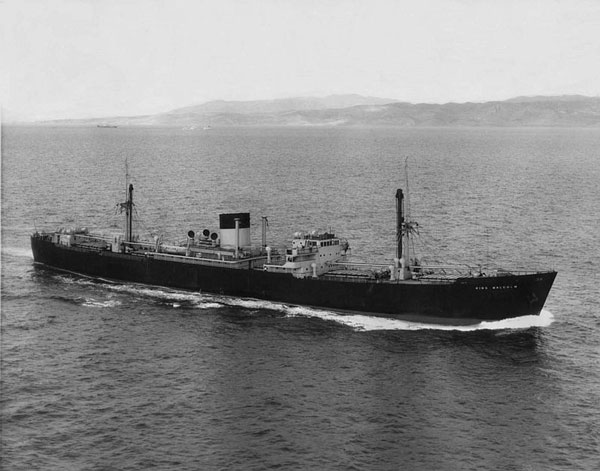
John Howard Blake
Canadian Merchant Navy
Unit: S.S. King MalcolmSon of Frederick William and Mary Emma (Bishop) Blake
Northwest River, Labrador
July 26, 1911 - October 31, 194
Enlisted:September 12, 1939
KIA Oct. 31, 1941
Previous service in the Canadian Army
(Artillery)
LABRADOR MAN LOST LIFE IN WWII U-BOAT ATTACK
JOHN HOWARD BLAKE
Born Grand Village (Mud Lake) on July 26, 1911 - Died October 31, 1941
By Clarice Blake RudkowskiLife dealt John Howard Blake many hard blows during his short lifetime.
When he was only three years old his mother, Mary Emma (Bishop) Blake died. The following year his father, Frederick William Blake, chopped his left knee with an axe while on the trap line.
Luckily, some fellow trappers found him before he either froze or starved to death, and trekked back to Grand Village (now Mud Lake) on snowshoes, hauling him on a sled. Sadly, Dr. Harry Paddon was on sabbatical in the United States that winter and no doctor was sent to replace him. As a result Fred's knee became so badly infected that it rendered him a cripple, which meant he was unable to trap again and therefore unable to provide for his very large family.
Many of his children were farmed out to relatives but John and an older sister, Phyllis, were admitted to the orphanage in St. Anthony, Newfoundland on September 2, 1916. Another brother, William (Bill) was sent to his maternal grandparents in Newfoundland.
Little 5-year old John was to stay in the orphanage for the next nine years, discharged on August 20, 1925, three weeks after his father had died. Life at the orphanage meant hard work (boys worked in the barn and carpenter shop, were involved in fishing, chopped wood and gardened, etc.); and the children were subjected to severe discipline.
However, they were the envy of the surrounding community because they enjoyed a better standard of living, became educated and most ended up with good jobs.
NO PAPER TRAIL
There is no paper trail to establish what John did for the next six years but my mother remembers that he did spend time at home, in Labrador, hunting and trapping and it would appear that he finally traveled to Nova Scotia where his brother Bill was working in the coalmines at Sydney, N.S. In Halifax on June 26, 1931 he enlisted as a Gunner in the Permanent Force of the Canadian Army until he was honourably discharged on July 25, 1936.He was called back into Active Duty, from Sydney, N.S., on September 12, 1939 until November 6, 1939, at which point it appears that he volunteered for service in the Canadian Merchant Marines.
BATTLE OF THE ATLANTIC
The Battle of the Atlantic, raging from 1939 to 1943, was the longest and most important battle of the Second World War when the Allies and Nazis fought for control of the ocean.Submarines, the proverbial 'Iron Coffins", were the scourge of shipping. Aircraft surveillance was provided 500 miles offshore from Iceland and 500 miles from the Island of Newfoundland. Vessels were at their most vulnerable outside this 500-mile limit, referred to as the Black Pit. Type 9 U-boats operated as "Lone Wolves" and mostly attacked unprotected shipping, while the "Wolf Pack" strategy was used to ambush the convoys.
The Merchant Marines ferried desperately needed supplies of food, gas and oil, weapons, ammunition, tanks, trucks, troops, etc. to the Allied forces in Europe who were waging war against the Nazis. They were in the thick of some of the war's most critical clashes.
However, many of their ships were cranky old coal-burners, susceptible to breakdown and often had only a top speed of six knots per hour. If a ship lagged behind the convoy it was usually not possible to wait for it. If it sank, the crew often perished in the freezing water.
Those who managed to stay afloat struggled to do so. Then the sharks arrived. Additionally, although the Nazis took prisoners early in the war, later, under instructions from Adolf Hitler, they began machine-gunning crews in the water. In retaliation some Allied crews did the same to Nazis abandoning ship.
KING MALCOLM LOST
After joining the Merchant Marines, John Blake first sailed with the Belgium registered "ASTRIDE", then on the "M.V. KING MALCOLM" O.N. 148713, built in 1925 and registered at Cardiff, Wales. The M.V. King Malcolm was under contract to the British Admiralty and at the time of her demise was carrying potash taken on at Sydney, N.S.According to the Registry of Shipping and Seamen from Cardiff, Wales they had sailed to Freetown, Sierra Leone; Table Bay, South Africa; Suez; Barry, Wales and Sydney, N.S.
It was on the return journey to Britain that John lost his life, along with the other 37 crewmembers on board, when a German submarine torpedoed them at 47 degrees 40 minutes North, 51 degrees 15 minutes West.
It is unclear which U-boat may have been responsible. Research has discovered two possible scenarios.Firstly, it could have been the U-106 commanded by Capt. Rasch, one of the top U-boat commanders of the war, decorated for top tonnage sunk. Capt. Rasch went on to prowl the seas until the end of the war. He was patrolling when he spotted the King Malcolm and ended her life on October 28, 1941.
It was claimed that it went down in three minutes with no survivors. However, a 'lost committee' determined the date to be October 31.
The second possibility, recorded in Hilter's U-Boat War, The Hunters 1939-42, attributes the sinking to the new V11C U-374, the only "Mordbrenner" boat left in Newfoundland waters by October 31, 1941.
Unno von Fischel commanded it, age 25, son of a WWI U-boat commander who was an Admiral in the Kriegsmarine.
Thirty-three days out from Kiel, on his maiden patrol, von Fischel was also critically low on fuel. The luckless hunt for ON 28 (convoy) had drawn him 50 miles SE of Cape Race, Newfoundland. There, while preparing to depart for France, he found and hit a lone 5,100 ton gross British freighter, the M.V. King Malcolm, which sank in 30 seconds. It went down before it could radio an alarm.
Young von Fichel and his sub later went to the bottom of the Mediterranean compliments of a British sub.
By virtue of his wartime service, John Howard Blake was awarded the 1939-45 Star, the Atlantic Star, the Canadian Volunteer Service Medal (C.V.S.M.) & Clasp and the War Medal 1939-45.
He laid down his life in the service of his adopted country, Canada.
The war did not discriminate when it came to victims. 2000 Allied merchant ships were sunk during the conflict and 781 German subs went to the bottom claiming countless lives.
Able Seaman JOHN HOWARD BLAKE is commemorated on Panel 19 of the Halifax Memorial at Point Pleasant Park, Halifax, N.S.; on the Merchant Marine Monument erected in St. John's, Newfoundland and Labrador; in the Book of Remembrance, Ottawa, Ontario; and on the commemorative pages of the Canadian Virtual War Memorial site:
http://www.vac-acc.gc.ca/general/sub.cfm?source=collections/virtualmem
Burial Information:
Cemetery: HALIFAX MEMORIAL
Nova Scotia, Canada
Grave Reference: Panel 19.
Location: The HALIFAX MEMORIAL in Nova Scotia's capital, erected in Point Pleasant Park, is one of the few tangible reminders of the men who died at sea. Twenty-four ships were lost by the Royal Canadian Navy in the Second World War and nearly 2,000 members of the RCN lost their lives.
This Memorial was erected by the Commonwealth War Graves Commission and was unveiled in November 1967 with naval ceremony by H.P. MacKeen, Lieutenant-Governor of Nova Scotia, in the presence of R. Teillet, then Minister of Veterans Affairs.The monument is a great granite Cross of Sacrifice over 12 metres high, clearly visible to all ships approaching Halifax. The cross is mounted on a large podium bearing 23 bronze panels upon which are inscribed the names of over 3,000 Canadian men and women who were buried at sea.The dedicatory inscription, in French and English, reads
as follows:
1914 1939
1918 1945
IN THE HONOUR OF
THE MEN AND WOMEN
OF THE NAVY
ARMY AND MERCHANT NAVY
OF CANADA
WHOSE NAMES
ARE INSCRIBED HERE
THEIR GRAVES ARE UNKNOWN
BUT THEIR MEMORY
SHALL ENDURE.
MV King Malcolm

